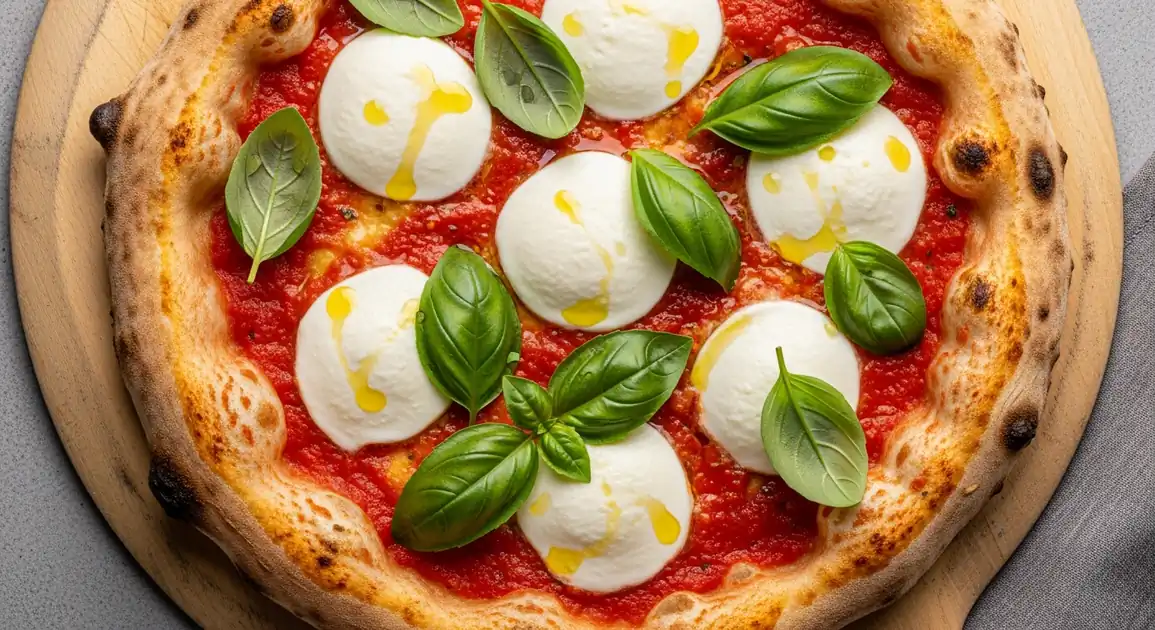Pizza Margherita
Pizza Margherita

Description
Naples is the birthplace of Pizza Margherita and upholds the strictest traditions regarding its preparation. The city takes immense pride in this culinary heritage, with pizza culture deeply embedded in daily life. Here, Pizza Margherita isn't just food but a cultural institution protected by the Associazione Verace Pizza Napoletana to preserve authentic methods.
Dietary Information
Serving information
Serving style
In Naples, Pizza Margherita arrives unsliced and is eaten with knife and fork. The center is often quite soft (a hallmark of Neapolitan style). 'Pizza a portafoglio' is folded twice and wrapped in paper for street eating.
Quick facts
Traditional pizzerias often open only for lunch (12 PM - 3 PM) and dinner (7 PM - midnight). Tourist-area establishments might stay open continuously.
Safety Tips
What to Look For
-
Wood-fired oven with visible flames
Traditional wood-fired ovens reach temperatures of 430-480°C (800-900°F), which ensure proper cooking and kill potential pathogens. The flame should be visible.
-
Fresh mozzarella being cut for each pizza
High-quality pizzerias use fresh mozzarella (fior di latte) that's cut or torn shortly before use, not pre-shredded or pre-sliced that's been sitting out.
-
Busy pizzeria with high turnover
Ingredients won't sit out long, and everything from dough to toppings will be fresher. In Naples, the best places often have lines.
-
Clean workspace visible to customers
Many traditional pizzerias have open kitchens. Look for clean counters, organized ingredient stations, and proper handling procedures.
-
Properly risen and cooked dough
The pizza should have air bubbles in the crust and show proper cooking with some charring. Undercooked, dense dough can lead to digestive issues and indicates poor preparation.
What to avoid
-
Pre-made or reheated pizzas
Authentic Pizza Margherita should be made to order and served immediately. Avoid places that seem to reheat or pre-prepare components.
-
Excessively thick or uniformly flat crust
This indicates either improper dough preparation or the use of a rolling pin (not traditional), affecting both authenticity and quality.
-
Shredded or processed mozzarella
Traditional Pizza Margherita uses fresh mozzarella torn into pieces, not pre-shredded cheese, which often contains anti-caking additives.
-
Tomato paste instead of fresh tomato sauce
Proper Margherita uses crushed San Marzano tomatoes, not thick paste. The sauce should be bright red and relatively light.
-
Dried basil instead of fresh leaves
Traditional Pizza Margherita should have fresh basil leaves, which are more flavorful and visually appealing than dried herbs.
Price information
Price range
Budget tips
- Most authentic local pizzerias charge €4-6 for a Margherita away from tourist centers.
- Famous historic pizzerias (L'Antica Pizzeria da Michele, Sorbillo, etc.) charge €7-10 but are worth the experience.
- 'Pizza a portafoglio' (folded pizza for street eating) costs only €1.50-3 from street vendors.
- Some places charge a small 'coperto' (cover charge) of €1-2 per person - this is normal.
Value indicators
- Long fermented dough (24+ hours) for better digestibility.
- Buffalo mozzarella option (Margherita Extra) for €1-2 more.
- Clear visibility of the wood-fired oven.
- Pizzaiolo (pizza maker) hand-stretching dough (never using a rolling pin).
- Historic pizzerias with long traditions but reasonable prices.
Where to Find This Dish
Centro Storico (Historic Center)
The heart of pizza culture with many historic and famous establishments.
Via dei Tribunali, Spaccanapoli, Piazza Dante
Lunch (12 PM - 2 PM), Dinner (8 PM - 10 PM)
Quartieri Spagnoli (Spanish Quarters)
Authentic neighborhood with excellent local pizzerias frequented by Neapolitans.
Via Speranzella, Via Toledo
Dinner (7:30 PM - 11 PM)
Mercato district
Home to some old-school pizzerias with excellent quality and local atmosphere.
Via Carbonara, Corso Umberto
Lunch, Dinner
Vendor Tips
- Be prepared to wait at famous places like L'Antica Pizzeria da Michele or Sorbillo - lines can be long.
- Look for the wood-fired dome oven ('forno a legna') and pizzaioli stretching dough by hand.
- True Neapolitan pizzerias display either the AVPN certification or clearly state they follow Neapolitan tradition.
- Many traditional places in Naples don't take reservations and operate on a first-come, first-served basis.
How to Order
Regional Variations
-
Margherita with Buffalo Mozzarella (Extra)
(Margherita con Mozzarella di Bufala (Extra))
The premium version in Naples uses D.O.P. buffalo mozzarella from Campania region instead of fior di latte. It costs €1-2 more but offers a richer flavor.
-
Antica Margherita (Old-Style)
(Margherita all'Antica)
Some historic pizzerias make an even more minimalist version, with less cheese scattered in patches rather than covering the entire pizza.
-
Margherita Fritta (Fried Pizza Margherita)
(Pizza Fritta alla Margherita)
A variation where the pizza dough is fried before being topped with tomato, cheese and basil - a street food specialty of Naples.
-
Pizza a Portafoglio
(Pizza a Portafoglio)
A smaller Margherita folded twice (like a wallet or handkerchief) for street consumption, often sold from small windows or street carts.
Cultural context
History
While flatbreads with toppings have existed for centuries, Pizza Margherita as we know it was reportedly created in 1889 by pizzaiolo Raffaele Esposito of Pizzeria Brandi in Naples. According to popular tradition, he prepared three different pizzas for Queen Margherita of Savoy during her visit to the city. The queen preferred the version with tomatoes, mozzarella, and basil, which coincidentally displayed the colors of the Italian flag. Esposito named this creation 'Pizza Margherita' in her honor. By 2009, the European Union granted Traditional Specialty Guaranteed status to Pizza Napoletana, protecting its authentic preparation methods.
Local significance
In Naples, pizza is a symbol of cultural identity and pride. UNESCO recognized the art of Neapolitan pizza-making ('pizzaiuolo') as part of humanity's intangible cultural heritage in 2017. Pizza represents Neapolitan ingenuity - creating excellence from simple ingredients.
Eating customs
- Pizza is eaten directly from the plate with knife and fork, starting from the tip or center.
- Neapolitans often ignore the unwritten Italian rule against cappuccino after breakfast when eating pizza.
- The soft center of Neapolitan pizza means folding it slightly with your fork is common practice.